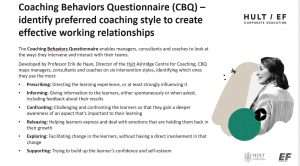Executive Coaches can react in diffent ways in a coaching engagement. A model looks at the coaching skills and behaviors, through six classes of interventions.
As an executive coach, you have a wide array of behavioral responses at your disposal at any moment in a coaching engagement. The sheer amount of possibilities can be a real source of doubt and anxiety (De Haan, 2008). As you move through your career, you will continue to spend time reflecting on which of these “interventions” to use and when. Likewise, your coaching client wonders what to say and when to say it.
Over the past few years there has been much discussion around this topic, as well as a proliferation of models. Most of this debate has been without much knowledge or evidence around which behaviors coaches think they use and which behaviors clients think they receive—and vice versa.
Basic model of coaching interventions
Over recent years, Hult Ashridge Centre for Coaching has developed and refined a model of coaching skills expressed in a psychometric tool, to help coaches hold up a mirror to their coaching and choose which particular skills they want to develop and define. This model is also useful to researchers.
To start investigating coaching skills, a basic model of interventions is needed and both clients and coaches need to be able to recognize each of the classes of intervention intuitively. Because of this, the model must be comprehensive and easily quantifiable, however not too detailed and complicated, with a limited number of classes so that reliable measurements can be made.
Our starting point was a model proposed by (Heron, 1975) which looks at coaching skills and behaviors in a broad sense, through six classes of interventions that a coach may use:
- Prescribing: Directing the learning experience, or at least strongly influencing it.
- Informing: Giving information to the learners, either spontaneously or when asked, including feedback about their results
- Confronting: Challenging and confronting the learners so that they gain a deeper awareness of an aspect that’s important to their learning
- Releasing: Helping learners express and deal with emotions that are holding them back in their growth
- Exploring: Facilitating change in the learners, without having a direct involvement in that change
- Supporting: Trying to build up the learner’s confidence and self-esteem.
Using these six categories of coaching interventions we developed the Coaching Behaviors Questionnaire (CBQ), containing 18 forced-choice questions, each having four answering categories. We chose this design so that the questionnaire aligned with questions coaches face in their practice on a day-to-day basis, as well as to reduce bias and generate more distinctive profiles.

Large scale study of coaching behaviours
The latest version of the CBQ questionnaire was used in a large-scale study of coaching behaviours among 537 coaches, 196 consultants, and 559 manager-coaches as well as 221 clients of coaching. The study explored coaching “skills profiles” for these different professions but also for different factors such as gender, age, experience, nationality. We were also able to compare coaches’ self-observation o…
Erik de Haan is Director of the Hult Ashridge Center for Executive Coaching and Professor of Organisational Development and Coaching at VU University Amsterdam. He has published nearly 200 technical and research articles and 16 books covering his major areas of expertise as a leadership and organization consultant, facilitator, supervisor, and coach.


